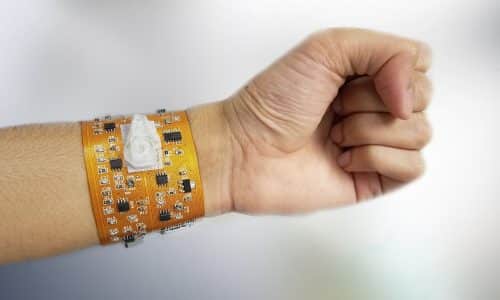Researchers have developed a patch that indicates how much cortisol is being generated through a person’s sweat. The hormone cortisol, which influences emotional stress, blood pressure, metabolism, immune response, and memory formation, changes naturally throughout the day, and can rise because of increased stress.
Contemporary methods for measuring cortisol levels require waiting several days for results from a lab. By the time a person learns the results of a cortisol test – which may inform treatment for certain medical conditions – it is likely different from the current level of cortisol.
Now, Alberto Salleo is leading a group of materials scientists at Stanford University, and has created a stretchy wearable biosensor patch that, when applied directly to the skin, picks up sweat and assesses how much cortisol a person is producing. A paper focused on the wearable sensor was published late July in Science Advances.
“We are particularly interested in sweat sensing, because it offers noninvasive and continuous monitoring of various biomarkers for a range of physiological conditions,” said Onur Parlak, a post-doctoral scholar and lead author of the paper. “This offers a novel approach for the early detection of various diseases and evaluation of sports performance.”
The clinical tests that measure cortisol are said to offer an objective gauge of emotional or physical stress in research subjects, and can help doctors ascertain if a patient’s adrenal or pituitary gland is working properly. Assuming the prototype version of this new wearable device is approved, the patch could allow people with an imbalance to monitor their own levels at home.
A fast-working test like this could also reveal the emotional state of young – even non-verbal – children, who might otherwise be unable to communicate that they feel stress.
According to a Stanford spokesperson, Parlak built his stretchy, rectangular sensor around a membrane that specifically binds only to cortisol. Stuck to the skin, it sucks in sweat passively through holes in the bottom of the patch. The sweat pools in a reservoir, which is topped by the cortisol-sensitive membrane. Charged ions like sodium or potassium, also found in sweat, pass through the membrane unless they are blocked by cortisol. The sensor detects those backed-up charged ions, not the cortisol itself. An additional waterproof layer protects the patch from contamination.
“I always get excited about a device, but the sweat collection system that Onur devised is really clever,” Salleo said. “Without any active microfluidics, he’s able to collect enough sweat to do the measurements.”
In order to view cortisol levels, the user merely needs to sweat (enough to glisten), apply the patch, and connect it to a device for analysis, which delivers results in seconds. In the future, the researchers hope that the sensor could be part of a fully integrated system.
Parlak himself gave the device a real-world test: he strapped on his running shoes and recruited two volunteers, all of whom ran for 20 minutes with the patches on their arms.
The sensors appeared to work as designed; nevertheless, the researchers want to increase its reliability and accuracy, and ensure that it is reusable. The prototype seems to work multiple times, when not completely saturated with sweat. In the future, its creators may try the cortisol sensor on saliva, which would allow patients to use it without needing to sweat.
SOURCE
https://news.stanford.edu/2018/07/20/wearable-device-measures-cortisol-sweat/





Comments: 2
What an invention
The sensors appeared to work as designed; nevertheless, the researchers want to increase its reliability and accuracy, and ensure that it is reusable.